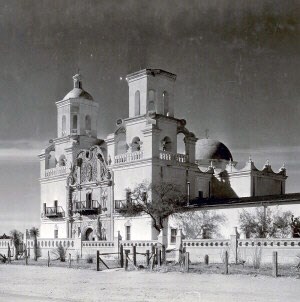
"Father Kino, whose first visit to the O'odham community of Wa:k (Bac) was in 1692, began to build a church there in 1700. It apparently never got beyond its foundations, however, and in 1751 the Jesuit Father Visitor Jacobo Sedelmayr said of the Indian community, 'It is still very backward without a catechist, without obedience, and without any church other than a ramada and a wretched house. It is clear to see that this village has been visited very little.' San Xavier's first church, other than a ramada, was a flat-roofed, hall-shaped adobe building begun shortly after the arrival of Jesuit missionary Father Alonso Espinosa in 1756. It was serviceable at least by 1763, although given the fact that Espinosa failed to level the site and there were no stone foundations, there must have been structural problems from the outset. "The adobe church built by Father Espinosa was the one inherited by Father Francisco Garcés when he arrived at San Xavier in 1768 as its first Franciscan minister." (The Pimeria Alta: The Southwest Mission Research Center) Bishop Antonio de los Reyes on 6 July 1772 wrote a report on the condition of the missions in the Upper and Lower Pimeria Alta. Following is his report on San Xavier del Bac as translated by Father Kieran McCarty:
"Improvements in the architectural situation at San Xavier had to await the arrival in 1776 of Father Juan Bautista Beldarrain, a Basque friar. Building San Xavier was an expensive proposition, but Father Beldarrain was able to borrow $7,000 pesos - the equivalent of more than twenty years of a missionary's salary - from a businessman, Don Antonio Herreros. The friar's only collateral was wheat from crops not yet planted - almost as if he expected Don Antonio to join him in his vows of poverty. The good Padre was never able to repay the debt; he died at San Xavier in 1790, the new church still undecorated and otherwise unfinished. It was Beldarrain's successor at San Xavier, Father Juan Bautista Llorens, who oversaw its completion by 1797. "Sometime early in the nineteenth century, probably in the 1820s, Father Espinosa's old church was torn down and its adobes, wooden columns, and ceiling beams were re-used to build a convento wing extending east from the east bell tower of the Franciscan structure. Today's church itself has interior and exterior walls of fired bricks set in lime mortar with an interior core filled with stone rubble over which lime mortar was poured periodically as the walls went up. The east bell tower, as well as interior decoration of a room apparently intended for large meetings of friars, was never finished. After the new temple at San Xavier was ready for use in 1797, Father Llorens directed his attention toward other building projects. One was the Tucson visita where he began either a renovation or a replacement for the Garcés chapel." (The Pimeria Alta, Southwest Mission Research Center) Following is Bishop Reyes' report on San Cosme y Damian de Tucson, a visita of Bac, as translated by Father Kieran McCarty:
|
Last updated: May 6, 2025
